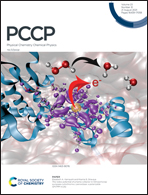Proton transport mechanism and pathways in the superprotonic phase of M3H(AO4)2 solid acids from ab initio molecular dynamics simulations†
Abstract
The proton transport mechanism in superprotonic phases of solid acids has been a subject of experimental and theoretical studies for a number of years. Despite this, details of the mechanism still need further clarification. In particular in the M3H(AO4)2 family of crystals, where M = NH4, K, Rb, Cs, and A = S, Se, the proton diffusion is mostly considered in the (001) plane, whereas it is relatively high in the [001] direction as well. In this paper, we report the results of our ab initio molecular dynamics simulations of the Cs3H(SeO4)2 superprotonic phase and propose an atomic-level mechanism of proton transport and pathways both in the (001) plane and along the [001] direction. It turned out that structural configurations formed by hydrogen-bonded tetrahedral anions during the proton diffusion are more complicated and diverse than those considered so far in the literature. Our predicted values of the proton conductivity and activation energy agree well with available experimental data. This validates the reliability of the computational results obtained.



 Please wait while we load your content...
Please wait while we load your content...